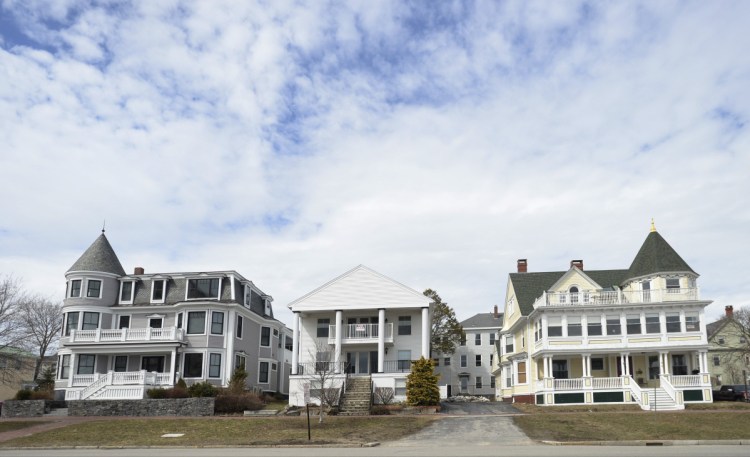Portland city councilors are expected to vote Monday on a proposal aimed at addressing development concerns in one of the city’s most desirable neighborhoods, where more traditional homes and apartment buildings are being torn down and replaced with large, boxy condominiums.
The proposed Munjoy Hill Conservation Overlay District would make it more difficult to demolish some architecturally significant buildings. It would also add new requirements to better ensure that new buildings are built in a similar style, size and scale with those that already exist.
However, the proposal being considered by the City Council stops short of creating historic districts, which would establish more stringent restrictions on what homeowners could do with their properties. Planners will continue to explore this possibility over the summer and fall.
“At this point, I can’t say where that’s going, because we definitely want to hear from affected property owners and do some more analysis before making a recommendation,” said Jeff Levine, the city’s planning and urban development director.
City Councilor Belinda Ray, who represents the East End, said she believes the proposal, which was drafted and vetted over the course of several community forums and recommended unanimously by the Planning Board, strikes the right balance between preservation and development. She said the proposal “goes a long way” toward addressing concerns raised by residents about their rapidly changing neighborhood.

Belinda Ray
“This is a boom time. People have construction fatigue,” said Ray, whose district includes the East End and India Street neighborhoods, which is seeing the most intense development in the city. “There is a lot of construction going on. But this is not going to stop that. What will change here is the quality of the projects that are coming through for development.”
The conservation overlay district is similar to a set of temporary rules adopted after the council ordered a moratorium on demolitions in December. It would apply to the R-6 zone on Munjoy Hill, an area roughly bounded by Washington Avenue, Mountfort Street, Fore Street and the Eastern Promenade.
Although the proposal would not prohibit tear-downs of existing buildings, it would allow city staff to postpone for up to 18 months the demolition of buildings deemed preferably to be preserved, which means they were built before 1930 and have retained their architectural integrity. The so-called demolition delay would allow time for the city’s Historic Preservation Board to issue a more formal ruling and for planners to work with the applicant on alternatives to demolition. However, the board’s ruling is non-binding, and the owner could tear down the building after the delay expires.
In terms of design standards, the overlay would prohibit the first floor of a building from being used as parking and sets design standards to address concerns over roof lines, among other things. The restriction is designed to maintain an active street-front of living spaces with doors and windows and avoid creating dead zones filled with garage doors.
The overlay zone would reduce the maximum building heights allowed on the hill. The current height limit is 45 feet, but the overlay zone would reduce that to 35 feet. But an additional 10 feet could be granted if the building has three or more units on a lot larger than 2,000 square feet or if the development includes at least one unit priced to be affordable to a middle-income resident.
Ray said she plans to offer an amendment to grant the full 45-foot height allowance only to projects that include at least one so-called “workforce housing unit.”
“We have said again and again that affordable housing is a priority for us,” Ray said. “We have more and more hotels coming into the area, which means we have more workers in the area and we need to provide the housing for that level of income.”
Although no formal recommendations are being made for historic districts, Ray said city planners will continue to discuss that possibility with area residents.
Back in April, planners created a map that showed the general areas for potential districts. One would have run along the Eastern Promenade and Fore Street from Turner Street to Atlantic Street, reaching a block or two from the outside edge into the neighborhood. The other would have run along North Street, from Congress Street to Walnut Street.
Greater Portland Landmarks, a nonprofit historic preservation advocacy group, has been studying the historic integrity of Munjoy Hill for several months. The group has offered its own proposals for potential districts that are slightly more encompassing than the city’s initial proposal. For example, the Eastern Prom/Fore Street district would extend beyond Atlantic Street, going as far as Waterville Street.
Portland currently has 11 historic districts. The most well-known include the West End, Congress Street and Portland Waterfront/Old Port. In 2015, the city created the India Street Historic District, and in 2016 it created a historic district for the former Portland Co. complex at 58 Fore St.
Munjoy Hill resident Karen Snyder is part of a group of 13 residents who have banded together under the name of Munjoy Hill Conservation Collaborative. That group has collected nearly 400 signatures in support of the proposed district recommended by the Planning Board, she said.
The collaborative, as well as the Munjoy Hill Neighborhood Organization, also supports future efforts to create several historic districts, beginning with the more encompassing districts proposed by Greater Portland Landmarks, Snyder said.
“We hope the 2018 Portland City Councilors will ensure that what made Munjoy Hill popular to live here in (the) first place is not erased for future generations,” she said in a May 21 email to councilors.
Randy Billings can be contacted at 791-6346 or at:
rbillings@pressherald.com
Twitter: randybillings
Send questions/comments to the editors.




Comments are no longer available on this story